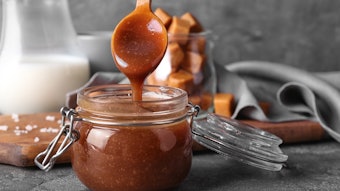
In this month’s column we evaluate ingredients from Capua 1880, a family-run business built across five generations since it was founded in 1880 in Reggio Calabria. Capua 1880 has been internationally recognized for their expertise and knowledge on citrus, specializing particularly on citrus oils and ingredients for flavors, as well as fragrances.
Organoleptic Evaluation Panelists
- Dr Andrea Albertino, Senior Flavorist, Esarom
- John Forbes, Consultant, Ceressence Consultancy
- Dr Bimal Karmakar, Principal Flavorist, Givaudan
- Jack Nicol, Flavorist, IFF
- Britta Nobis, Senior Flavorist, Silesia
- Dr Maria Palassarou, Flavorist, Givaudan
- Dr Ján Peťka, Head of Flavor Development, Austria Juice
- Aine Walsh, Senior Flavorist, Keurig Dr Pepper
Orange Back-End
FEMA #2825, CAS #8028-48-6, 8008-57-9
Botanical Origin: Citrus sinensis, (L) OSBECK.
Status & process: 100% Natural Complex Substance. Short path concentration process of single-fold cold-pressed orange oil.
Key Volatiles: Decanal 8-12%, linalool 8-12%, citral 15-19%, limonene 8-12%, sesquiterpenes 7-19%.
Odor Descriptors @100%: Aldehydic, soapy, waxy, fatty, sweet orange, juicy, floral, pithy, woody, complex.
Taste Descriptors @1ppm: Aldehydic, juicy, sweet orange, pithy, woody, fatty, citrus peel, slightly metallic, mouth feeling.
Possible applications: As a concentrated fraction of orange oil carbonyls and sesquiterpenes, it would provide body complexity as well as taste and mouthfeel to all orange flavor profiles. The characteristic aldehydic, sweet orange and woody notes would fit well on various citrus profiles for beverage and confectionary applications. Its juicy, sweet element would also help on orange juice replacements, as also on fruit punches profiles.
Head-Block fraction ex Orange
FEMA #2826, CAS #8028-48-6, 68606-94-0
Botanical Origin: Citrus sinensis, (L) OSBECK.
Status & process: 100% Natural Complex Substance – First fractions extraction from Orange Back End oil via molecular evaporation.
Key Volatiles: Decanal 15-20%, geranial 15-20%, neral 8-12%, dodecanal 6-10%, limonene ≤8%.
Odor Descriptors @100%: Aldehydic, soapy, waxy, fatty, sweet, juicy, green, floral, slightly herbal notes.
Taste Descriptors @1ppm: Soapy, waxy, aldehydic, albedo, coriander notes, juicy, sweet, green, herbal notes.
Possible applications: As a concentrated fraction of orange oil carbonyls, and particularly aldehydes, it would provide body and impact to all orange flavor profiles. Apart from sweet orange tonalities, its characteristic aldehydic note would also fit well to other citrus profiles, such as blood orange, mandarin, tangerine, grapefruit. Moreover, its waxy, green element would be a great addition in melon profiles.
Body-Block fraction ex Orange
FEMA #2826, CAS #8028-48-6, 68606-94-0
Botanical Origin: Citrus sinensis, (L) OSBECK.
Status & process: 100% Natural Complex Substance – Obtained from Orange Back End oil via molecular evaporation on multi-pass process.
Key Volatiles: Valencene ≥67%, cadinene ≤10%.
Odor Descriptors @100%: Sweet orange, woody, juicy, fruity, floral violet, pithy, aldehydic.
Taste Descriptors @1ppm: Woody, juicy, spicy, floral violet, sweet orange, powdery, slightly aldehydic.
Possible applications: As a concentrated orange oil sesquiterpene fraction, containing mainly woody valencene and less back-end sesquiterpenes, it would provide complexity, body and long-lasting impact to all orange flavor profiles. Its woody, floral character would also fit well to other citrus profiles, such as blood orange, grapefruit, mandarin for beverage and confectionary applications. The Head-Block fraction ex Orange ingredient can be used in blood orange applications.Roman Ivaschenko at Adobe Stock
The Head-Block fraction ex Orange ingredient can be used in blood orange applications.Roman Ivaschenko at Adobe Stock
Tail-Block fraction ex Orange
FEMA #2826, CAS #8028-48-6, 68606-94-0
Botanical Origin: Citrus sinensis, (L) OSBECK.
Status & process: 100% Natural Complex Substance – Obtained from Orange Back End oil via molecular evaporation on multi-pass process.
Key Volatiles: Valencene ≥7%, α-sinensal ≥6%, β-sinensal ≥8.5%.
Odor Descriptors @100%: Sweet, woody, pithy, albedo, juicy, candy, jammy, fatty, slightly aldehydic, herbal notes.
Taste Descriptors @1ppm: Woody, pithy, albedo, slightly aldehydic, citrus peel, juicy, cooked, grapefruit notes, metallic, bitter flavonoid taste.
Possible applications: As a concentrated orange oil sesquiterpene fraction, it would provide complexity, body, long-lasting taste and mouthfeel. Ideal for confectionary and beverage applications to give citrus and mixed fruit flavors prolonged orange character. Its sweet, candy element would fit well on marmalade, tart and other cooked fruit profiles. The characteristic pithy, albedo note would benefit mandarin and tangerine profiles, whereas its woody spicy element could be a great addition to whisky and cola flavors. Moreover, the bitter metallic taste, due to orange residue content, could help on bitter orange or bitter herbal flavor profiles.
Orange Compact Deco
FEMA #2825, CAS #8028-48-6, 8008-57-9
Botanical Origin: Citrus sinensis, (L) OSBECK.
Status & process: 100% Natural Complex Substance – Obtained from single-fold orange oil, highly concentrated with its natural derivatives and orange juice extract.
Key Volatiles: Limonene 55-75%, linalool ≤12%, geranyl acetate ≤6.5%, citral ≤2.5%.
Odor Descriptors @100%: Sweet orange, floral, juicy, fresh, fruity, estery, ethereal, aldehydic, zesty, perfume notes.
Taste Descriptors @10ppm: Sweet orange, floral, fruity, ethereal, aldehydic, soapy, peely, bergamot note.
Possible applications: Orange Compact Deco, oil enhanced on key heavy molecules but retaining the fresh and juicy top notes, would fit well on sweet orange profiles, as also orange juice tonalities providing freshly squeezed citrus notes. Its fruity, estery element would make it ideal for orange flavor profiles for children, whereas the zesty note would also benefit lemon flavor profiles. Moreover, the floral bergamot character would make it a great addition to tea flavors, such as Earl grey.
Lemon Compact Deco
FEMA #2626, CAS #84929-31-7, 8008-56-8
Botanical Origin: Citrus limon, (L) BURM.f.
Status & process: 100% Natural Complex Substance – Obtained from single-fold lemon oil, highly concentrated with its natural derivatives and lemon juice extract.
Key Volatiles: Citral 30-55%, limonene 9-25%, geranyl acetate ≤11%, γ-terpinene ≤6%.
Odor Descriptors @100%: Sweet lemon, zesty, juicy, fresh, floral, peely, coumarin notes.
Taste Descriptors @10ppm: Juicy, sweet lemon, zesty, peely, floral, lemongrass notes.
Possible applications: Lemon Compact Deco, oil enhanced on key aroma molecule citral but retaining the fresh and juicy top notes, would fit well on freshly squeezed lemon flavor profiles. Its characteristic sweet lemon element would make it a great addition for lemon candy flavors, as also lemon sherbet profiles. The lemon zesty note would benefit limoncello flavors, whereas its floral coumarin aspect would fit well on Earl grey type tea profiles. The lime compact deco ingredient could be used for cola flavor profiles.Fonlinepix at Adobe Stock
The lime compact deco ingredient could be used for cola flavor profiles.Fonlinepix at Adobe Stock
Lime Compact Deco
FEMA #4849, CAS #90063-52-8, 8008-26-2
Botanical Origin: Citrus aurantifolia, (Christman) SWINGLE.
Status & process: 100% Natural Complex Substance – Obtained from single-fold lime oil, highly concentrated with its natural derivatives.
Key Volatiles: Citral 24-41%, limonene 20-35%, γ-terpinene 5-15%.
Odor Descriptors @100%: Lime expressed type notes, juicy, sweet lemon, zesty, floral, lemongrass, coumarin notes.
Taste Descriptors @10ppm: Sweet lemon notes, juicy, peely, floral, coumarinic.
Possible applications: Lime Compact Deco, lime expressed type oil enhanced on key aroma molecule citral but retaining the juicy top notes, would fit well on lemon-lime flavor profiles for beverage applications. Its characteristic sweet lime element would make it also a great addition for sweet lime flavors for confectionary applications. Moreover, the sweet, coumarinic lime note would give complexity to cola flavor profiles.
Mandarin Compact Deco
FEMA #2657, CAS #84929-31-7, 8008-31-9
Botanical Origin: Citrus reticulata, BLANCO.
Status & process: 100% Natural Complex Substance – Obtained from single-fold mandarin oil, highly concentrated with its natural derivatives mandarin juice extract.
Key Volatiles: methyl-N-methylanthranilate ≤18%, limonene 45-60%, γ-terpinene 6-18%.
Odor Descriptors @100%: Floral, fruity, spicy, pithy, peely, aldehydic, fatty, woody musty, medicinal notes.
Taste Descriptors @10ppm: Floral, fruity, pithy, fatty, aldehydic, woody, spicy, medicinal, herbal, green.
Possible applications: Mandarin Compact Deco, oil enhanced on key aroma molecules but retaining the juicy top notes, would fit well on various citrus flavor profiles for beverage applications, such as mandarin and tangerine due its pithy spicy character, and also blood orange due its floral notes. Its characteristic floral, musty element would make it a great addition for concord grape flavors. Moreover, the spicy ,terpenic notes could benefit spice mix profiles, whereas its medicinal herbal character might fit well in spirits tonalities, like gin flavors.
Bergamot Compact Deco
FEMA #2153, CAS #89957-91-5, 68648-33-9/8007-75-8
Botanical Origin: Citrus bergamia, RISSO et POITEAU.
Status & process: 100% Natural Complex Substance – Obtained from single fold bergamot oil, highly concentrated with its natural derivatives & juice bergamot extract.
Key Volatiles: Linalyl acetate 50-65%, linalool 15-25%, limonene 5-15%.
Odor Descriptors @100%: Floral, sweet, bergamot, lavender, herbal, soapy, lime notes, perfumery.
Taste Descriptors @10ppm: Floral, sweet, bergamot, lavender, woody, soapy, metallic, slightly cardamom notes, lime.
Possible applications: Bergamot Compact Deco, oil enhanced on key aroma molecule linalyl acetate characteristic of the sweet floral bergamot note, would be the ideal addition for Earl grey tea flavor profiles. Its characteristic floral, sweet element would make it also a great addition for orchard fruit profiles, like peach and apricot, as well as honey and brown flavors like chocolate. Moreover, its floral, woody lavender note would give complexity to dried fruit and tobacco flavor profiles, as also to Gin tonalities providing a Juniper berry characteristic note.










